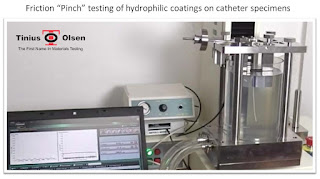Automated Friction "Pinch" testing of Hydrophilic Coatings on Catheters

These days angioplasty, is an endovascular procedure to widen narrowed or obstructed arteries or veins, is almost considered a routine procedure, yet the technology behind it is exacting and subject to rigorous quality and performance control. In this procedure a n empty, collapsed balloon, known as a balloon catheter, is passed over a wire into the narrowed locations and then inflated to a fixed size. The balloon forces expansion of the narrowing within the artery or vein and the surrounding muscular wall, opening up the blood vessel for improved flow, and the balloon is then deflated and withdrawn. A stent may, or may not, be inserted at the time of ballooning to ensure the vessel remains open. Not only are the stents themselves, and the wire used in their construction, tested for tensile strength, compressive strength and stiffness properties, so too are the balloon catheters used to deliver the stent into the body. In recent times, more attention is being paid to...
